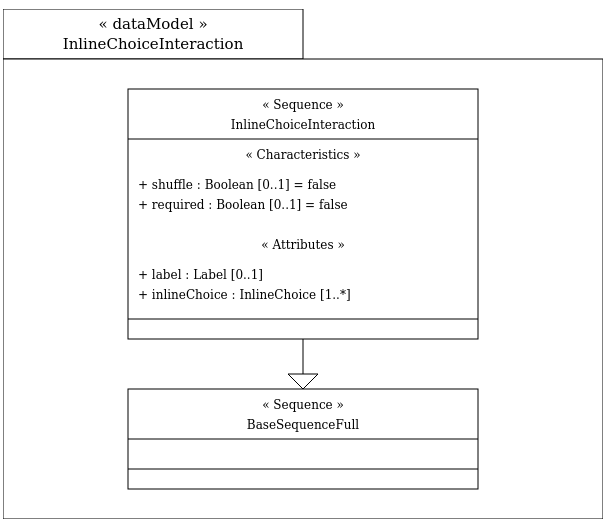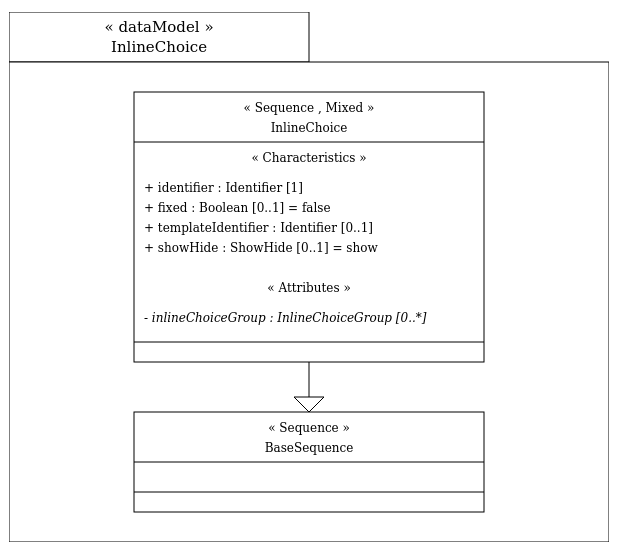Inline Choice Interaction (QTI)
An inline choice is an inlineInteraction that presents the user with a set of choices, each of which is a simple piece of text. The candidate’s task is to select one of the choices. Unlike the choiceInteraction, the delivery engine must allow the candidate to review their choice within the context of the surrounding text. The inlineChoiceInteraction must be bound to a response variable with a baseType of identifier and single cardinality only.
The relevant classes are:
Data Model


Example

The Richard III (Take 1) example above demonstrated the use of filling gaps from a shared stock of choices. In cases where you only have one gap, or where you have multiple gaps that are to be filled independently, each from its own list of choices, then you use an inlineChoice interaction.
A ‘label’ element can be provided to display default text in the place of the inlineChoiceInteraction, which allows some flexibility in display, especially if more than one interaction is used in the same assessmentItem.
<assessmentItem xsi:schemaLocation="http://www.imsglobal.org/xsd/imsqti_v2p2 http://www.imsglobal.org/xsd/qti/qtiv2p2/imsqti_v2p2p2.xsd" identifier="inlineChoice" title="Richard III (Take 2)" adaptive="false" timeDependent="false">
<responseDeclaration identifier="RESPONSE" cardinality="single" baseType="identifier">
<correctResponse>
<value>Y</value>
</correctResponse>
</responseDeclaration>
<outcomeDeclaration identifier="SCORE" cardinality="single" baseType="float"/>
<itemBody>
<p>
Identify the missing word in this famous quote from Shakespeare's Richard III.
</p>
<blockquote>
<p>
Now is the winter of our discontent
<br/>
Made glorious summer by this sun of
<inlineChoiceInteraction responseIdentifier="RESPONSE" shuffle="false">
<inlineChoice identifier="G">Gloucester</inlineChoice>
<inlineChoice identifier="L">Lancaster</inlineChoice>
<inlineChoice identifier="Y">York</inlineChoice>
</inlineChoiceInteraction>
;
<br/>
And all the clouds that lour'd upon our house
<br/>
In the deep bosom of the ocean buried.
</p>
</blockquote>
</itemBody>
<responseProcessing template="http://www.imsglobal.org/question/qti_v2p2/rptemplates/match_correct"/>
</assessmentItem>
Math example:
<assessmentItem xsi:schemaLocation="http://www.imsglobal.org/xsd/imsqti_v2p2 http://www.imsglobal.org/xsd/qti/qtiv2p2/imsqti_v2p2p2.xsd" identifier="inlineChoiceMath" title="Inline Math" adaptive="false" timeDependent="false">
<responseDeclaration identifier="RESPONSE" cardinality="single" baseType="identifier">
<correctResponse>
<value>choice2</value>
</correctResponse>
</responseDeclaration>
<outcomeDeclaration identifier="SCORE" cardinality="single" baseType="float"/>
<itemBody>
<p>Answer the question.</p>
<blockquote>
<p>
If
<m:math>
<m:mrow>
<m:mi>a</m:mi>
<m:mo>=</m:mo>
<m:mi>b</m:mi>
</m:mrow>
</m:math>
and
<m:math>
<m:mrow>
<m:mi>b</m:mi>
<m:mo>=</m:mo>
<m:mi>c</m:mi>
</m:mrow>
</m:math>
then
<inlineChoiceInteraction responseIdentifier="RESPONSE" shuffle="false">
<inlineChoice identifier="choice1">
<m:math>
<m:mrow>
<m:mi>x</m:mi>
<m:mo>=</m:mo>
<m:mi>y</m:mi>
</m:mrow>
</m:math>
</inlineChoice>
<inlineChoice identifier="choice2">
<m:math>
<m:mrow>
<m:mi>a</m:mi>
<m:mo>=</m:mo>
<m:mi>c</m:mi>
</m:mrow>
</m:math>
</inlineChoice>
<inlineChoice identifier="choice3">
<m:math>
<m:mrow>
<m:mi>b</m:mi>
<m:mo>=</m:mo>
<m:mi>d</m:mi>
</m:mrow>
</m:math>
</inlineChoice>
</inlineChoiceInteraction>
.
</p>
</blockquote>
</itemBody>
<responseProcessing template="http://www.imsglobal.org/question/qti_v2p1/rptemplates/match_correct"/>
</assessmentItem>